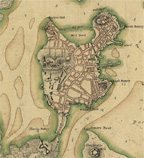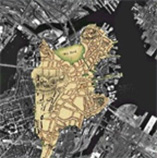GEOLOGY OF BOSTON
Boston geology is complex and varied. Many areas of downtown Boston are built on landfill placed between the late 1700s and the 1960s. The images below show the extent of fill placed in Boston between the year 1776 and the satellite image of today. Soil mixed with bricks, wood, ash, concrete, gravel, sand, and other materials was dumped in low-lying areas and fronted by piers and bulkheads. Beneath the fill is a layer of organics, including silt, sand, peat, and shells. A marine clay known as Boston blue clay lies below the organic layer. This clay can vary in stiffness from very soft to very stiff. During the glacier ice age, sheets of ice advanced and retreated, grinding away the soil down to bedrock. At the bottom of the ice sheet, boulders, sand, silt, gravel, and clay were deposited atop the bedrock to form a dense layer called till. Below the till is bedrock. The primary bedrock formation is a metamorphosed shale called Cambridge Argillite. Intermixed with the argillite are formations of roxbury conglomerate, diabase, and sandstone.
These complex conditions combined with a high water table create often treacherous below ground working conditions. East Coast Slurry has performed some of the deepest and most technically challenging foundation projects in this environment. Special methods have included structural slurry walls for permanent and temporary conditions, soldier pile tremie concrete (SPTC) slurry walls, load bearing elements (LBEs), and slurry trenches. Our knowledge and expertise of underground works in Boston is unsurpassed.








